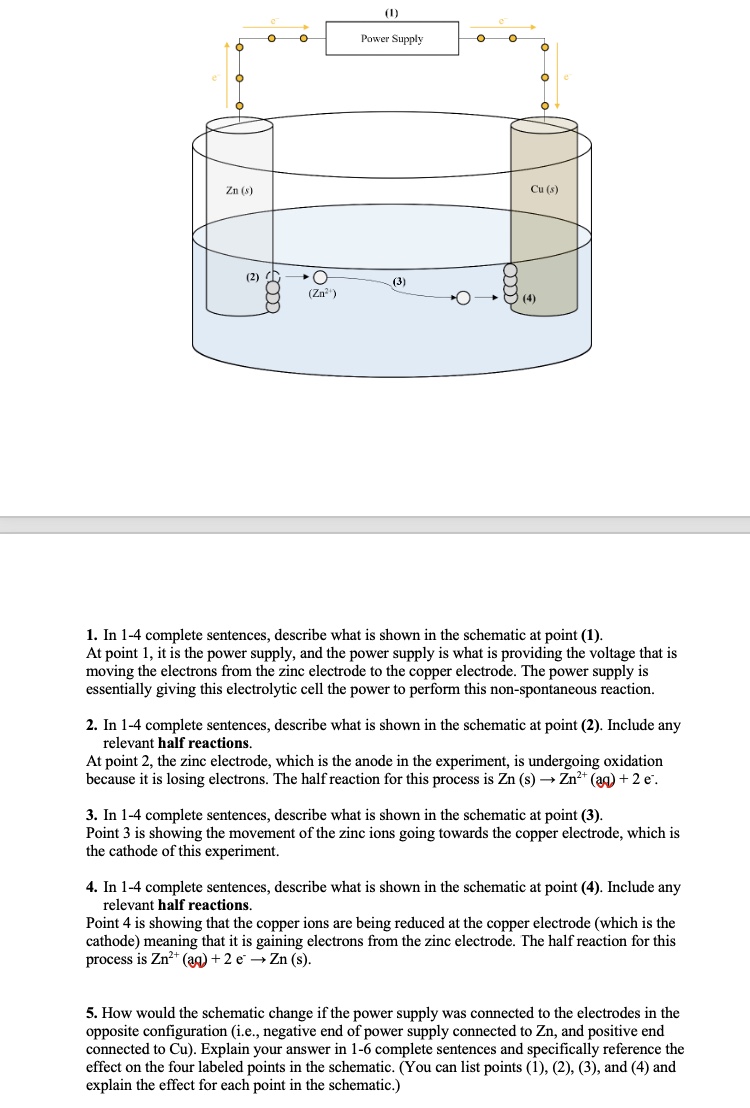1. In 1-4 complete sentences, describe what is shown in the schematic at point (1). 2. In 1-4 complete sentences, describe what is shown in the schematic at point (2). Include any... 1. In 1-4 complete sentences, describe what is shown in the schematic at point (1). 2. In 1-4 complete sentences, describe what is shown in the schematic at point (2). Include any relevant half reactions. 3. In 1-4 complete sentences, describe what is shown in the schematic at point (3). 4. In 1-4 complete sentences, describe what is shown in the schematic at point (4). Include any relevant half reactions. 5. How would the schematic change if the power supply was connected to the electrodes in the opposite configuration (i.e., negative end of power supply connected to Zn, and positive end connected to Cu)? Explain your answer in 1-6 complete sentences and specifically reference the effect on the four labeled points in the schematic. (You can list points (1), (2), (3), and (4) and explain the effect for each point in the schematic.)

Understand the Problem
The question presents a schematic of an electrolytic cell with zinc and copper electrodes. It asks to describe what is happening at different points in the cell (1-4), including relevant half-reactions. Finally, it asks how the schematic would change if the power supply were connected in the opposite configuration.
Answer
Here are the answers to your questions about the schematic and its changes with reversed power supply configuration. See the full answer for details.
Here are the answers to your questions:
- At point 1, it is the power supply, and the power supply is what is providing the voltage that is moving the electrons from the zinc electrode to the copper electrode. The power supply is essentially giving this electrolytic cell the power to perform this non-spontaneous reaction.
- At point 2, the zinc electrode, which is the anode in the experiment, is undergoing oxidation because it is losing electrons. The half reaction for this process is Zn (s) → Zn2+ (aq) + 2 e.
- Point 3 is showing the movement of the zinc ions going towards the copper electrode, which is the cathode of this experiment.
- Point 4 is showing that the copper ions are being reduced at the copper electrode (which is the cathode) meaning that it is gaining electrons from the zinc electrode. The half reaction for this process is Cu2+ (aq) + 2e- → Cu (s).
- If the power supply was connected in the opposite configuration, the following changes would occur: (1) The power supply would now be forcing electrons to flow from the copper electrode to the zinc electrode. (2) The copper electrode would become the anode, and copper would undergo oxidation: Cu(s) → Cu2+(aq) + 2e-. (3) Copper ions would move towards the zinc electrode. (4) At the zinc electrode (the cathode), zinc ions would be reduced to form solid zinc: Zn2+(aq) + 2e- → Zn(s).
Answer for screen readers
Here are the answers to your questions:
- At point 1, it is the power supply, and the power supply is what is providing the voltage that is moving the electrons from the zinc electrode to the copper electrode. The power supply is essentially giving this electrolytic cell the power to perform this non-spontaneous reaction.
- At point 2, the zinc electrode, which is the anode in the experiment, is undergoing oxidation because it is losing electrons. The half reaction for this process is Zn (s) → Zn2+ (aq) + 2 e.
- Point 3 is showing the movement of the zinc ions going towards the copper electrode, which is the cathode of this experiment.
- Point 4 is showing that the copper ions are being reduced at the copper electrode (which is the cathode) meaning that it is gaining electrons from the zinc electrode. The half reaction for this process is Cu2+ (aq) + 2e- → Cu (s).
- If the power supply was connected in the opposite configuration, the following changes would occur: (1) The power supply would now be forcing electrons to flow from the copper electrode to the zinc electrode. (2) The copper electrode would become the anode, and copper would undergo oxidation: Cu(s) → Cu2+(aq) + 2e-. (3) Copper ions would move towards the zinc electrode. (4) At the zinc electrode (the cathode), zinc ions would be reduced to form solid zinc: Zn2+(aq) + 2e- → Zn(s).
More Information
The electrolytic cell uses a power supply to drive a non-spontaneous redox reaction. Reversing the power supply leads to the reversal of the redox reaction at each electrode.
Tips
Pay close attention to the direction of electron flow and the definitions of oxidation (loss of electrons) and reduction (gain of electrons).
AI-generated content may contain errors. Please verify critical information